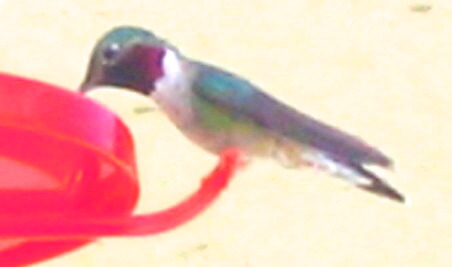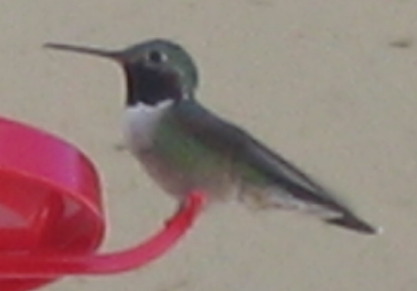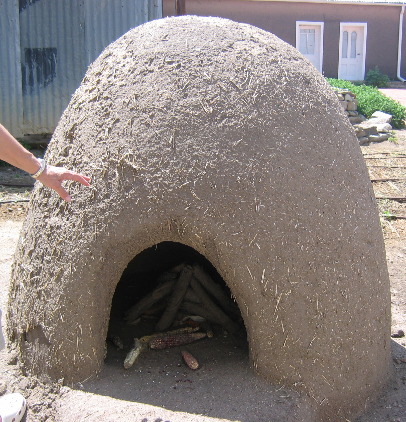Trinidad, ColoradoTuesday, June 6 2006: Raton, New Mexico (On I-25 on the Colorado border). We are in Cedar Rail Campground N36° 59.334 W104° 28.951'. Cedar Rail Campground is located on I-25 at the summit of Raton Pass. It is totally gravel with pull-thru & back in sites (trees are limited) but they do have several large ones; 50-amps, water and sewer, $11 per-night with PPA or $23 with Good Sam 505-278-2921 the owners are delightful, the sunsets are spectacular and the humming birds down right amusing. Black chinned humming bird at Cedar Rail Campground
Black chinned humming birds at Cedar Rail RV-Park; Raton Pass, New Mexico. Cedar Rail RV Park is at the summit of Raton Pass on I-25.
Black chinned humming bird at Cedar Rail Campground
Raton Pass and the campground are at 7,500' so it is a good climb up and over the pass. Our day was spent in Trinidad, Colorado 13-miles north of the campground. Trinidad is a small town with a lot of history. Trinidad was the first city in this area of Colorado. It was settled as a result of the Santa Fe Trail that passed that way. The Purgatoire River flows through town. Later coal mines made many people rich. The town has preserved many homes and buildings from the 1800's and early 1900's. We took a free trolley tour of the city that was really informative plus we spent several hours in the Santa Fe Trail Museum. You probably thought I spelled the Purgatoir River wrong, well, you would be wrong. Let me tell you a bit about the Purgatoir River before I explain the spelling. The Purgatoir River has its headwaters in the towering Sangre de Cristo Mountains that rise to the west of Trinidad. Melting snow fields provide water that feeds the river and its tributaries. American Indians, fur trappers, Santa Fe Trail traders, and pioneers relied on the Purgatoire River. Today the water in the Purgatoire is only used for irrigating crops. No fishing or nor city water. Now I will explain why the funny spelling of the Purgatoire. Spaniards called the river El Rio de Las Animas Perdidas en Purgatorio, or River of Souls Lost in Purgatory. Legend says a party of Spanish explorers perished by the river without the benefit of last rites, relegating their souls to purgatory. French fur trappers pronounced it Purgatoire. "Picketwire," based on the French pronunciation, was used by some settlers. Today, they use the French spelling, Purgatoire, but the English pronunciation, Purgatory. Now you know why the funny spelling. Horno
The Santa Fe Trail Museum had a real "horno" or beehive-shaped outdoor adobe oven on display. To make tortillas, women started a fire on the hornos interior base then placed a comal, or griddle, on the coals. To achieve higher temperatures, the cooks made a wood fire or several consecutive fires. After the fires burned down, they removed the coals with an iron scoop. Intense, radiant heat absorbed by the adobe cooked the food. Families prepared a variety of foods, including pies, cookies, bread, tamales, stews, and meats in hornos, which are as versatile as the modern oven. For overnight cooking, they sealed the oven by mudding over the vent and door. Savory aromas escaped into the night air as carne adobada (pork slices marinated in a red chile puree) and other local specialties simmered in their adobe chamber. To pull pots and pans from the hornos, they used a long wood paddle. Trinidad was a town that resulted from the Santa Fe Trail. The Santa Fe Trail was a trade route from 1821 until the 1880's when the railroad reached Santa Fe, New Mexico. Prior to 1821 New Mexico (Santa Fe) was a Spanish possession. The Spanish did not trade with the English, French, or Americans. The Spanish forbad any of the native peoples in New Mexico from trading with anyone other than Spain. Mountain Men, fur trappers, and would be traders that ventured into Spanish Territory were imprisoned or worse. Spain jealously protected its territory from outsiders. Just so you will know how serious Spain was in keeping "outsiders" out of their territory Pike (the Army Officer that Pike's Peak is named after) was captured ( in 1807) by the Spanish while on his mission and held as a spy ---- which he was. If you will recall from your high school history lessons Pike was sent out to explore specific portions of the Louisiana Purchase. Specifically the expedition was to explore the headwaters of the Arkansas and Red rivers and explore the Red River to its mouth on the Mississippi. In addition since large swathes of the southwest edge of the Louisiana Purchase were disputed between the United States and Spain. Pike and his expedition were to determine what ability Spain had to defend that claim, if pressed.
This should give you a good indication of how serious Spain was about not allowing "foreigners" into their territory. However, in 1821 Mexico declared independence from Spain and things changed. In 1821, William Becknell and five companions were welcomed to Santa Fe, Capital of newly independent Mexico's northernmost province where they sold what goods they had. This profitable trip inspired a second venture in 1822, this time with wagons. Becknell's success prompted a rush to join the new trade. Once Mexico won independence, American traders and settlers were welcomed and Mexicans found new markets in "Los Estados" (the States). By the 1840's, wagon trains owned by Mexican merchants were as common as those owned by Americans. Some Mexican traders made buying trips to St. Louis, New York, and Europe. New Mexico was starved for manufactured goods in the earliest years of trade. Traders found a ready market for U. S. manufactured textiles (especially calico), metal tools, religious objects, and notions. The Mexican American War (1846-1848 brought New Mexico and much of the southwest into the territorial United States. Many New Mexican traders, now American citizens, continued freighting on the Santa Fe Trail. There was more than one way to travel from Missouri to Santa Fe. For 25-years, the flatter, direct Cimarron Route was the primary wagon road across the southern Plains; but it crossed arid lands that included 50 to 60 miles with isolated water sources. And as this traffic disrupted Plains Indian lifeways, conflicts between traders and Indian tribes became more frequent. By the 1840's, the Mountain Route-45 miles longer-offered more dependable water, and less exposure to Indians was the predominate route. But and it is a BIG but, it funneled travelers over steep, difficult Raton Pass (on the border of Colorado and New Mexico). Not until "Uncle Dick" Wootton built a toll road in 1865 did this route become practical for wagons. This "toll road" over Raton Pass is what thrust Trinidad into the big time. Uncle Dick Wootton was a character like some of those down in Cimarron in fact Uncle Dick was one of those that used to frequent the St. James Hotel in Cimarron.
Although most people didn't like paying his toll, many enjoyed Uncle Dick's company at his Inn on the pass. Like Lucien Maxwell's mansion Uncle Dick's mansion on Raton Pass included an Inn, Restaurant, Saloon etc., Uncle Dick was born in Virginia in 1816 to a farm family. When Richens Lacy Wootton headed west he began a colorful life as a mountain man and frontier entrepreneur. After selling beaver belts to the Hudson Bay Company and traveling to Los Angeles, Wootton was back in Colorado in 1840. A few years later Wootton was trading tobacco, knives, vermillion beads, guns, and ammunition to Ute Indians in exchange for mules, ponies, buckskins, buffalo robes, and Navajo blankets. In 1858 Wootton spent Christmas Eve in a gold mining camp near Denver. After hauling wagons of goods, including whiskey kegs, from New Mexico Wootton rolled out some barrels and shared the whiskey. In appreciation, the revelers called him "Uncle Dick" and the nickname stuck. Wootton's other exploits/accomplishments included; He was a scout on John Fremont's western exploratory expedition. He was good friends with Kit Carson. In the 1850's he opened a store, saloon and inn in Denver. In 1861 he moved to Pueblo, Colorado where he had a buffalo farm. He drove sheep to California to sell to gold miners. He ran a trading post in Denver. Wootton was a large gregarious man known for his story-telling, strong opinions and generosity. A friend said, he "was a rough hombre when in liquor." But it was building and operating the toll road over Raton Pass that was his crowning accomplishment. You can say we had a good day in Trinidad and found it a place that we could spend more time. But it will have to be on another trip. We are headed to Idaho this summer and if we don't get a move on we might not make it. VBG
Click here for some Colorado travellogsUntil next time remember how good life is. More Colorado AdventuresAdventures by State ** More 2006 Travel Adventures
Mike & Joyce Hendrix
Mike & Joyce Hendrix who we are We hope you liked this page. If you do you might be interested in some of our other Travel Adventures: Mike & Joyce Hendrix's home page Travel Adventures by Year ** Travel Adventures by State ** Plants ** Marine-Boats ** Geology ** Exciting Drives ** Cute Signs ** RV Subjects ** Miscellaneous Subjects
We would love to hear from you......just put "info" in the place of "FAKE" in this address: FAKE@travellogs.us Until next time remember how good life is.
|
| ||
|
| |||
|
| |||
|
|



